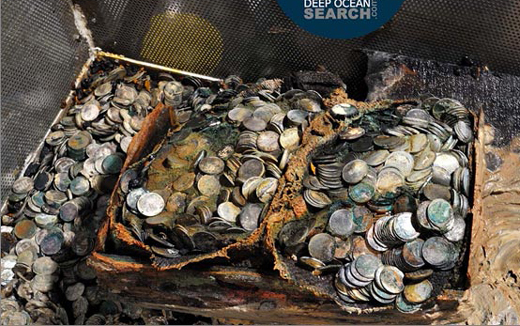Tons of 1 rupee British raj coins found in 1942 shipwreck
mangaloretoday.com
London, April 17: Over 70 years after a British steampship from Bombay carrying tons of Indian 1 rupee silver coins to help fund Britain in World War II was torpedoed by a German submarine, its wreck has been discovered in a record deep-dive operation.
The SS City of Cairo (Captain William Rogerson) was a mixed cargo and passenger ship belonging to Ellerman Lines and was on a voyage from Bombay to England, via Cape Town and Recife, Brazil, unescorted, in late 1942, in the middle of World War II.

The wreck British steampship carrying tons of Indian 1 rupee silver coins to help fund Britain in World War II has been discovered in a record deep-dive operation. (Photo Courtesy: Deep Ocean Search)
The ship carried 296 people of which 136 were passengers and a mixed cargo including some 100 tons of silver coins belonging to the UK Treasury. It was spotted by U-68 on the 6th of November 1942 and torpedoed near St Helena in the south Atlantic at 2030 hrs.
The story of the torpedo is known and has been the subject of at least one book, but the shipwreck was never found until Deep Ocean Search (DOS), a company specialising in such operations, took on the challenge under a contract with the UK government.
The company gets to keep an unspecified amount of the coins under the contract with the Ministry of Transport. DOS said it recovered several tens of tons of silver coins from a depth of 5150m – a world depth record. The haul is expected to be worth millions of pounds.
The story goes that the surviving crew and passengers were in lifeboats when the submarine approached to question captain Rogerson. The U-Boat captain, Karl-Freidrich Merten, told him how far he was from Brazil and left saying, “goodnight, sorry for s
DOS said: “This was to be a difficult search as the water depth would exceed 5000m, the weather, swell and currents were known to be challenging and the presumed site was some 1000 miles from the nearest land in the foothills of the mid-Atlantic ridge”.
It added: “Our research came up with the usual contradictions between the positions given by the submarine and that from the ships officers. A large search box was put together to try to reconcile these diverse statements. The seafloor was difficult with ridges and canyons throughout the area and the water depth varied between 5100 and 5500m”.
Divers founds that the ship was broken in two and buried deep in the seafloor silt. Parts of the ship had meters of mud heaped upon it.
“The combination of pressure, temperature, repeated dives at this depth and other issues resulted in multiple breakdowns of systems such as we had not experienced before when working in 3000 - 4000m depths…However our team overcame them”.
The DOS team left a plaque commemorating the finding and visiting the ship before they left the site finally.
- Mangaluru Hosts Karnataka State Police Run-2025
- Protest Against Wakf Amendment Bill Held in Mangaluru
- Missing Student Ran Away Over Exam Fear: Superintendent of Police
- Kasaragod: Missing Schoolgirl and Driver Found Dead in Merkala Forest After 26 Days
- The Intriguing Story Behind Diganth’s Mysterious Disappearance!
- Tamil Nadu CM M.K. Stalin’s Wife Visits Kollur Mookambika Temple
- Mangaluru Couple Completes Mumbai-to-Mangaluru Marathon, Eyes Guinness Record
- Eminent Aloysian Alumni Award 2025 Honors Five Achievers
- Udupi: Women Have Proved Their Strength in Every Field, Says Sri Sugunendra Thirtha Swami
- Missing II PUC Student Diganth found in Udupi after 10-day search
- Daylight burglary: Gold ornaments stolen from house in Vittal
- Illegal cattle transport: Three arrested after car crash near Gangolli
- District BJP stages protest; alleges injustice to DK in state budget
- Devotees Flock to Prayagraj’s Sangam Even After Maha Kumbh Ends
- India Condemns Vandalism at Hindu Temple in California, Calls for Strict Action
- Delhi CM Rekha Gupta-led cabinet approves ₹2,500 monthly aid for women
- After Ranya Rao’s arrest, CBI to probe international gold smuggling ring
- In a first, all-women crew runs Vande Bharat on International Women’s Day
- Elderly woman falls after wheelchair delay, Air India flags late arrival
- Jinnah must be happy with Siddaramaiah’s budget, says CT Ravi
- Chess star to Space scientist: Women achievers take over PM Modi’s X handle
- Two women, including Israeli tourist, raped near Hampi
- Over 140 killed in clashes between Syrian forces and Assad loyalists
- Actor Ranya Rao admits to role in gold smuggling; DRI gets 3-day custody
- Relief for Siddaramaiah’s wife in MUDA case, probe agency summons cancelled
- Court remands Maoist Lakshmi to six-day police custody
- Sandhya Shenoy honored with Society for Materials Chemistry Medal-2024
- White Cornus Apartment in Mangaluru
- City girl wins first place in state-level spell bee competition
- Alleged ‘Love Jihad’ Case in Mangaluru: Woman left home voluntarily, says police
- Girl fatally struck by reckless two-wheeler near Belman
- New residential complex for the judges inaugurated in Mangaluru
- Absconding accused nabbed after 8 years
- Truck with cylinders turns turtle in Beltangady
- Bhoota Kola artist dies of cardiac arrest
- Development of the country should be our goal: Ganesh Karnik
- Container truck gets stuck under Modankap railway bridge
- Truck crushes bike’s pillion rider near BC Road
- Head constable dies of heart attack
- Udupi: PDO dismissed over financial irregularities
- CITY INFORMATION
- TRAVEL
- TOURIST INFORMATION
- HEALTH CARE
- MISCELLANEOUS




 Write Comment
Write Comment E-Mail To a Friend
E-Mail To a Friend Facebook
Facebook Twitter
Twitter  Print
Print 



